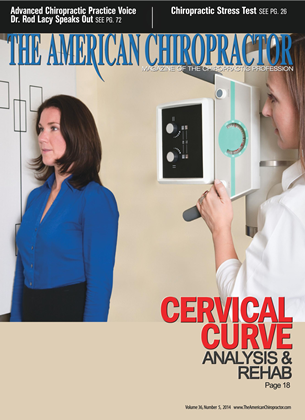History and Presenting Symptoms A 38-year-old female describes a history of occasional pain in her lower back region, most notably on the right side. She states that her low back pain "just starts and stops" with no obvious triggering activities. Her pain is localized to the posterior hip region and does not extend below the pelvis. She enjoys walking, running, and occasionally roller-skating for recreational purposes, but she recalls no specific injury or trauma to her lower back. On a 100 mm visual analog scale, she rates the pain in her lower back and pelvic region as varying from 35 mm to 55 mm. She takes over-the-counter NSAIDs when the pain in her lower back interferes with her "fun" activities or job duties in the hotel management industry. Exam Findings Vitals. This active female weighs 145 lbs. which at 5'7" results in a BMI of 22.7. so she is in the "normal" category. She reports that she works out semi-regularly on resistance machines at a local exercise center and makes time to walk or run at least three times per week. She is a nonsmoker. does not consume alcohol, and her blood pressure and pulse rate are within normal ranges (BP. 118/78 mmHg: pulse rate. 72 bpm). Posture and gait. Standing postural evaluation finds evidence of a lower iliac crest on the left, but the greater trochanters are level. The right ilium is rotated forward with prominence of the right ASIS. Her knees and ankles are well aligned, but there is obvious medial bowing of both Achilles tendons, with pes planus and hypcrpronation bilaterally. During gait, both feet demonstrate a moderate toe-out. Inspection of her shoes finds scuffing and wearing at the lateral aspect of both heels. Chiropractic evaluation. Motion palpation identifies limitations in segmcntal motion at the right SI joint with localized tenderness. The right SI joint demonstrates loss of end-range mobility, and pain is reported during motion testing. Gacnslcn's and Yeoman's tests for SI joint dysfunction both cause increased pain when perfonned on the right side. Lumbar ranges of motion arc within expected nonns. and neurologic testing is negative for sensory, motor, and reflexive disorders. Imaging A lumbopclvic scries (AP and lateral lumbopclvic views) is taken in the upright position during relaxed standing. The sacral base angle is 39 degrees and the lumbar lordosis measures 46 degrees. There is no significant discrepancy in femur head or iliac crest heights, and no lateral listing or lateral curvature is noted. Clinical Impression Moderate lumbopclvic fixation with chronic mechanical dysfunction of the right sacroiliac joint. Poor biomcchanical support is noted in the lower extremities, which exacerbates her lumbopclvic dysfunction syndrome. Treatment Plan Adjustments. Specific chiropractic adjustments for the lumbosacral and sacroiliac joints were provided as needed. Side-posture adjustments were well tolerated and resulted in good articular releases. Support. She was provided with individually designed stabilizing orthotics to provide support for her arches and also to decrease the biomcchanical stress on her pelvis and sacroiliac joints during the full gait cycle (heel strike, midstancc. toe off). Rehabilitation. She was instructed in a daily core strengthening program at home using elastic exercise tubing. The focus was on activation of her transverse abdominis musculature for improved spinal-pelvic stability. Response to Care This patient responded well to her spinal adjustments, and she adapted very quickly to her orthotics. She demonstrated good exercise performance at her rehab review sessions. After two months of adjustments (eight visits), she was released to a self-directed home exercise program. Discussion This patient had a chronic pelvic fixation, which was associated with pronation and biomcchanical dysfunction in the lower extremities. Her chiropractic treatment plan included orthotics to support her strained lower extremities and specific exercises to improve her core pelvic stability. She responded well to her adjustments, but also needed support from orthotics and professional guidance for her corrective exercises. Dr. John J. Danchik, the seventh inductee to the ACA Sports Hall of Fame, is a clinical professor at Tufts University \ ledical School and formerly chaired the I,'.S. Olympic ("ommillee s C "himpraclic Selection Program. Dr. Danchik lectures on current trends in sports chiropractic and rehabilitation. lie can be reached al docforjocs'daol.com or 617-489-1220.
 View Full Issue
View Full Issue









